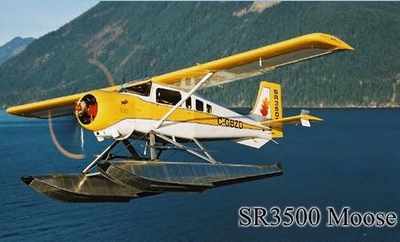NTSB Preliminary Report Indicates His Airplane Did Not Catch
Fire Until AFTER He Landed Safely
Here's an instance where the pilot of a homebuilt
utility airplane seems to have done everything
right when he smelled fuel in the cockpit, and lost the aircraft
anyway. The good news is the Arizona-based builder-pilot was able
to safely land his airplane off-airport and get clear. But he was
not able to stop the fire that broke out later and destroyed his
aircraft. In this case, the second apparent fuel issue to crop up
with the aircraft was fatal to the Murphy Moose.

Murphy Moose File Photo Radial Engine
NTSB Identification: WPR11FA258
14 CFR Part 91: General Aviation
Accident occurred Sunday, June 12, 2011 in Aguila, AZ
Aircraft: Bowley Murphy, registration: N189SB
Injuries: 1 Uninjured.
This is preliminary information, subject to change, and may
contain errors. Any errors in this report will be corrected when
the final report has been completed.
On June 12, 2011, about 0630 mountain standard time, an
experimental amateur-built Murphy Moose, N189SB, was consumed by
fire following a forced off-airport landing about 11 miles east of
Aguila, Arizona. The owner-pilot was not injured. The personal
flight was operated under the provisions of Title 14 Code of
Federal Regulations Part 91. Visual meteorological conditions
prevailed, and no flight plan had been filed for the flight.
The pilot based the airplane at Phoenix Deer Valley Airport
(DVT) Phoenix, Arizona, and departed DVT about 0600 to practice
landings and takeoffs on unprepared airstrips about 45 miles to the
northwest. Shortly before 0630, when the airplane was circling at
an altitude of about 1,400 feet above ground level, the engine
started to lose power. The pilot increased the throttle setting,
which temporarily seemed to help, but then the engine began to
surge, and the pilot smelled fuel. He checked the cockpit for signs
of fuel, found none, and then turned the airplane to head for
Wickenburg Municipal Airport (E25). The engine continued to lose
power, and the airplane began to lose altitude, so the pilot
decided to conduct a precautionary landing on a nearby highway.
While on a left base traffic pattern leg for the landing on the
highway, the engine lost power. Since he did not believe he could
reach the highway, the pilot opted to land on the desert terrain.
The touchdown and rollout were uneventful; the airplane was
undamaged, and the pilot was uninjured. After the pilot secured the
airplane, he exited, and noticed fuel dripping from the engine
compartment. A fire erupted inside the engine compartment, and the
pilot was unable to limit or extinguish the fire.

According to FAA information, the airplane was manufactured by
the pilot in 2006. According to the pilot, the airplane was
equipped with a fuel-injected Chevrolet Corvette LS6 engine that
utilized a "high pressure" fuel system. The pilot stated that all
fuel lines forward of the firewall were fire-sleeved. FAA-provided
information,which documented a similar event in September 2006,
involving the same pilot and the same airplane. The pilot was
taxiing at DVT when a fire erupted in the engine compartment; the
cause was attributed to a fuel line that became disconnected, and
sprayed fuel onto the hot engine.
According to the pilot, he held a private pilot certificate with
a single-engine land rating. He reported a total flight experience
of 2,000 hours, including 405 hours in the accident airplane make
and model. His most recent FAA third-class medical certificate was
issued in January 2011, and his most recent flight review was
completed in February 2010.
 ANN's Daily Aero-Linx (04.13.24)
ANN's Daily Aero-Linx (04.13.24) ANN's Daily Aero-Term (04.13.24): Beyond Visual Line Of Sight (BVLOS)
ANN's Daily Aero-Term (04.13.24): Beyond Visual Line Of Sight (BVLOS) Airborne 04.09.24: SnF24!, Piper-DeltaHawk!, Fisher Update, Junkers
Airborne 04.09.24: SnF24!, Piper-DeltaHawk!, Fisher Update, Junkers Aero-News: Quote of the Day (04.14.24)
Aero-News: Quote of the Day (04.14.24) ANN's Daily Aero-Term (04.14.24): Maximum Authorized Altitude
ANN's Daily Aero-Term (04.14.24): Maximum Authorized Altitude




